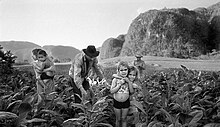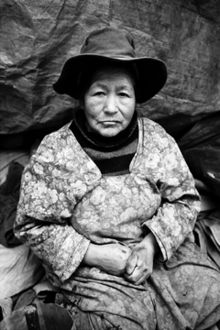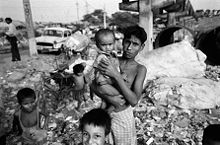Manuel Rivera-Ortiz
Manuel Rivera-Ortiz | |
|---|---|
 Manuel Rivera-Ortiz, Paris, France, 2009 | |
| Born | December 23, 1968 |
| Nationality | Puerto Rican American |
| Notable credit(s) | 2004: En Foco New Works Photography Award. 2007: Artist of the Year, Arts & Cultural Council for Greater Rochester |
| Website | http://www.rivera-ortiz.com |
Manuel Rivera-Ortiz (born December 23, 1968 in Pozo Hondo, Guayama, Puerto Rico) is an American documentary photographer, the author of several photographic collections and the recipient of a number of awards. He is best known for his documentary photographs of people's living conditions in less developed countries.[1] Rivera-Ortiz lives in Rochester, New York, in New York City and in Zurich.
Early life
Rivera-Ortiz was born into a poor family in the Barrio of Pozo Hondo, outside the Pueblo (City) of Guayama on the Caribbean Coast of Puerto Rico. He grew up in a corrugated tin shack with dirt floors without running water.[2][3] His father hand-chopped sugar cane in the fields of Central Machete and Central Aguirre in the declining days of the Puerto Rican sugar industry[4] (a 'central' is a mill located in the center of a sugar cane field), and, following the Zafra or sugar-harvesting season, labored as a migrant farm worker in New England and the Mid-Atlantic states.
When Rivera-Ortiz was 11 years old, his parents separated and his father moved with the children to the US mainland in Holyoke, Massachusetts. Rivera-Ortiz attended classes at Mt. Holyoke and Springfield colleges as part of the Massachusetts Migrant Education summer program, where he was offered his first courses in photography and film development. The family later moved to Rochester, New York.
Although Spanish is his original language, Rivera-Ortiz graduated from East High School (Rochester, New York) with Regents and AP English and other language classes. In 1995, Rivera-Ortiz graduated cum laude as an English Major from Nazareth College, and in 1998 he received his Master's degree from the Columbia University Graduate School of Journalism. Following his graduation he worked as a journalist for newspapers and magazines (e.g. Elle, Democrat and Chronicle). He then turned to photojournalism and documentary photography.

Photographic career

Rivera-Ortiz is noted for his social documentary photography of people's living conditions in less developed nations.[5][6][7][8][9] His photographs are in permanent collections of several museums, including the George Eastman House International Museum of Photography and Film.[10][11] In 2004 he received En Foco's New Works Photography Award,[12][13] and in 2007 the Artist of the Year Award of the Arts & Cultural Council for Greater Rochester.[14] In 2002, he photographed Cuba, comparing the conditions he found there to the Puerto Rico of his youth.[15] He has exhibited photographs showing the dignity of the Dalit ("Untouchable") Caste of India [16][17] and the Aymara living in the arid altiplano of Bolivia.[18] He has also exhibited work from Kenya to Turkey to Thailand.[19] The University of Puerto Rico, in conjunction with the Museum of Art of Puerto Rico (Museo de Arte de Puerto Rico), featured Rivera-Ortiz' work in courses on contemporary photographers. His work has been featured in the April 2008 issue of Rangefinder.[2] In 2009, he founded the Manuel Rivera-Ortiz Foundation for International Photography which supports underrepresented photographers, in particular from less developed countries. In 2010, Rivera-Ortiz visited Dharavi and Baiganwadi and took pictures of daily life in these two Mumbai slums.
Quotes

This file may be deleted at any time.
"Manuel Rivera-Ortiz's Cuba series, is like a cinema verité journey, through a landscape both accessible and mythic. His panoramas capture a connection to an environment that prods the senses. One feels enveloped by a familiar, primal place. It is this place which will hopefully anchor a vibrant social order, as it braces itself for the tremors gathering momentum on the horizon. The engaging photograph of two little girls holding each other, surrounded by lush vegetation, workers and family members speak to the continuity and bonds of love and vision of one’s own paradise." —Frank Gimpaya, Photographer and Adjunct Lecturer, Saint Peter's College
"What is palpable and distinctive about Rivera-Ortiz’ photographs is their profound humanity. The heart knows. And Rivera-Ortiz’ heart instructs him to recognize in a street corner of a remote village, the universal within the specific. He sculpts out of the landscape a look, a sky, a river, spices on the roadside, mother and child, a man missing an arm. Manuel Rivera-Ortiz makes it possible for us to journey with him and see what is not always readily apparent to the human eye. He goes beyond recording these simple truths. He has the courage to first experience them as his own, and then the will to bring them home to the rest of us—a compelling invitation to open up our own hearts."—Susana Tubert, Executive Producer & Co-Founder of TeatroStageFest (Manhattan)
"Manuel Rivera-Ortiz’s photographs of people living in poor villages in Turkey and Thailand, Bolivia and India don’t falsely romanticize their subjects’ poverty nor do they explicitly critique the political or economic systems that create such conditions. By focusing purely on the people who populate the poor global villages he visits, he captures the entire range of human emotion: mistrust, fear, curiosity, friendliness, happiness. Social critique may simmer below the surface of his work, but the primary message of Rivera-Ortíz’s images seems to be that hope and creativity are not mutually exclusive to poverty."—Nick Stillman, Editor, New York Foundation for the Arts “Current”
"The irony about my photography is that making these pictures constantly reminds me of my past. But life continues without regard for my own struggles growing up. It is for this reason that today I make these pictures to lend the voice I have been given to those who like me then, are still living in poverty today." [20]—Manuel Rivera-Ortiz
"For the first 12 years of my life I never knew what it was to have anything. For much of my life we lived in a shacks with no running water, electricity, a stove, a fridge, common amenities... One of our homes had a dirt floor... In fact I never came to touch a telephone until we moved from the island to the States. We were constantly on the move in some form or another going from living in our own shack to moving in with family when things got really rough. Once we’d settle in, we’d pick up and leave to start all over again. Changing school all the time was the worse, I must have attended a half a dozen schools by the age of 12 with all the constant upheaval. I am surprised that in the end I was able to finish school with honors and on time. That was a great blessing despite all of the difficulties."—Manuel Rivera-Ortiz
Exhibitions
Selected solo exhibitions
- 2008 Swiss Re, Zurich, Switzerland
- 2008 Nuyorican Poets Café, New York, NY
- 2007 Memorial Art Gallery, Rochester, NY
- 2007 William Whipple Art Gallery, Southwest Minnesota State University, Marshall, MN
- 2007 Columbia University Joseph Pulitzer Graduate School of Journalism, New York, NY
- 2007 El Museo Francisco Oller y Diego Rivera, Buffalo, NY
- 2004 Link Gallery, City Hall, Rochester, NY
- 2004 Weitmann Gallery, Washington University, St. Louis, MO
Selected group exhibitions
- 2007 Art Off The Main, Art Expo, Puck Building, New York, NY
- 2007 The Centre Gallery, Miami Dade College, Wolfson Campus, Miami, FL
- 2006 George Eastman House, Rochester, NY
- 2005 Chelsea Art Museum, New York, NY
- 2003 Credit Suisse, New York, NY
Publications
- Percepciones en Blanco & Negro - Colombia, Ediciones Adéer Lyinad, 2009 Fotografia Colombiana
- Voices in first person, Simon & Schuster, 2008, ISBN 1416984453 Simon & Schuster
- A Journey of Self-Discovery, Rangefinder Magazine PDF-Online
- Viajeros: North American Artist / Photographers’ Images of Cuba, Lehigh University Art Galleries, 2005
Collections
- Columbia University Graduate School of Journalism, NY
- George Eastman House, Rochester, NY[10]
- Lehigh University Art Galleries, Bethlehem, PA[21]
See also
References
- ^ "The next Manuel Rivera-Ortiz?". The Esther Benjamins Trust. Retrieved 2010-07-28.
- ^ a b "A Journey of Self-Discovery" (PDF). Rangefinder, The Magazine for Professional Photographers. April 2008. p. 126. Retrieved 2010-04-10.
{{cite news}}: Cite has empty unknown parameter:|coauthors=(help) - ^ Glennie Seychew, Christa (January 2007). "An Interview With Photographer Manuel Rivera-Ortiz". Buffalo Rising. Retrieved 2010-03-07.
- ^ The Rise and Decline of Puerto Rico's Sugar Economy
- ^ Democrat & Chronicle April 3, 2005, pg C1
- ^ Metropolitan Magazine; Arts & Cultural Council, Rochester NY, cover story Spring 2007
- ^ ConXion Magazine (a Gannett publication) interview: September 2007, pg. 4
- ^ Living Australia (Mead Publishing) Issue No. 8 (2006), pgs 28-29.
- ^ Ian Wright Travel Photography
- ^ a b "2006 Annual Report" (PDF). George Eastman House. p. 9. Retrieved 2010-01-24.
{{cite news}}: Cite has empty unknown parameter:|coauthors=(help) - ^ ConXion Magazine, interview February 2007, pg. 10-11
- ^ EN FOCO Photographers
- ^ Nueva Luz Magazine, Vol. 11, No. 2, pgs. 2-9, 2006.
- ^ Arts & Cultural Council "Arts Awards Recipients". Arts and Cultural Council for Greater Rochester. Retrieved 2010-01-27.
{{cite web}}: Check|url=value (help) - ^ ConXion Magazine cover story, August 2004
- ^ Democrat & Chronicle December 17, 2006, cover story, Section C
- ^ "Kodak Presents Manuel Rivera-Ortiz Exhibit of India". Imaging Info. Retrieved 2010-03-07.
- ^ ConXion Magazine cover story August 2005, pgs. 10-11
- ^ "Picturing My Life". New York Foundation for the Arts. Retrieved 2010-01-27.
- ^ "Quotations from the World of Photography". PhotoQuotes.com. Retrieved 2010-05-09.
{{cite news}}: Cite has empty unknown parameter:|coauthors=(help) - ^ Permanent Collection Lehigh University Art Galleries
Further reading
- An Interview with Photographer Manuel Rivera-Ortiz, Interview in Buffalo Rising
- Rochester City Newspaper: "Manuel Rivera-Ortiz: India"
External links
- Official Homepage
- The Jeff Farias Show Interview with Manuel Rivera-Ortiz, September 15, 2009
- Thoughts on Photography with Paul Giguere Interview with Manuel Rivera-Ortiz, July 23, 2009
- PhotoQuotes.com Quotations from the World of Photography
- JacketFlap About Manuel Rivera-Ortiz
- The Jeff Farias Show Manuel Rivera-Ortiz returns, June 15, 2010
- American photographers
- American photojournalists
- Social realist artists
- Mount Holyoke College alumni
- Nazareth College (New York) alumni
- Springfield College alumni
- Columbia University alumni
- 1968 births
- Living people
- People from Rochester, New York
- American humanitarians
- American philanthropists
- Puerto Rican visual artists
- People from Monroe County, New York
